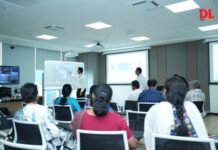Whilst East Asia is close to meeting the Millennium Development Goal of Education for All, in 2004 South Asia still had only 80% of students accessing primary education. But what about the quality of that education? The UNESCO (2005) report of the sixth meeting of the working group on Education for All states that 60% of children passing through primary school are still failing to acquire basic literacy skills. Nelson Mandela is one of the many who has described education as “the most powerful weapon observed which you can use to change the world” so improving the quality of education is vital. Does ICT hold the key? What are countries in Asia learning from each other and the rest of the world?
There is little evidence that developing countries are making use of the growing body of research and evidence from countries that have spent many years searching for and trialling successful methods of implementing technology in education to improve learning. The rationale for the use of ICT in educational development is also fuelled by the rhetoric that almost every government around the world believes technology and education are the keys to competitive advantage. Many countries within Asia are racing to be at the advent of the technology transformation in their area, and groups of countries within a region are working together to become the global leaders. It is therefore widely accepted that echnology has a real and relevant place in the classroom not just to equip students with the digital
 Technology has a real and relevant place in the classroom not just to equip students with the digital literacy skills needed for the Information age, but also to improve access to understanding through te use of multi-modal representations of difficult-to-grasp concepts. It is important to understand what level and what type of access to Information and Communication Technology is necessary to raise achievement to justify the expenditure on wiring up schools, connecting them to the Internet and providing the necessary student-PC ratio. This again needs to be coupled with education transformation process which seeks to align urriculum, assessment and learning opportunities to the needs of the world in which students will live, work and play
Technology has a real and relevant place in the classroom not just to equip students with the digital literacy skills needed for the Information age, but also to improve access to understanding through te use of multi-modal representations of difficult-to-grasp concepts. It is important to understand what level and what type of access to Information and Communication Technology is necessary to raise achievement to justify the expenditure on wiring up schools, connecting them to the Internet and providing the necessary student-PC ratio. This again needs to be coupled with education transformation process which seeks to align urriculum, assessment and learning opportunities to the needs of the world in which students will live, work and play
literacy skills needed for theInformation Age, but also to improve access to understanding through the use of multi-modal representations of difficult-to-grasp concepts. It is also important to understand what level and what type of access to ICT is necessary to raise achievement to justify the expenditure on wiring up schools, connecting them to the Internet and providing the necessary student-PC ratio. However the introduction of ICT is not enough. ICT needs to be coupled with education transformation which seeks to align curriculum, assessment and learning opportunities to the needs of the world in which students will live, work and play and which will prepare the learners ccordingly. Harvey and Knight (Transforming Higher Education, 1996, Buckingham, Open University Press and Society for Research into Higher Education) provide an excellent description of education transformation, which includes: • shifting from teaching to learning • developing explicit skills, attitudes and abilities as well as knowledge • developing appropriate assessment procedures • rewarding transformative teaching • encouraging discussion of pedagogy • providing transformative learning for teachers • auditing improvement ICT can be a catalyst to support and accelerate this transformation and can educe costs, but not until we change how we make ffective and efficient use of this limited resource. Currently ICT is being used to teach what we already teach and have taught for decades instead of considering where teachers can specifically make use of the interactivity and multimedia
capability to help make learning easier and more accessible. The tasks given to students and the assessment strategies employed still focus on the “what” ather than on the “how” and the “why”, which does not necessarily prepare students for the needs of the modern workplace. The argument is no longer about teachers being the transmitters of knowledge, and teachers are now positioned within a constructivist notion of “teacher as facilitator”. As our understanding of cognition and metacognition grows this view of teaching has taken hold almost globally, yet the rhetoric is far from reality. In both the developed and the developing world many commentators perceive technology as the catalyst that will change pedagogy. However for technology to have that impact, the educational model that supports a constructivist view of pedagogy must be viewed as central to the process, which is then supported rather than dictated to by the technology. The educational model takes a central role and connectivity, technology, content and teacher training are then focused and aligned to support this model. This idea seems obvious yet it does not appear to be central to decision making in many countries about electronic content development and deployment, or implementation of technology into schools or teacher training. In the model there are two factors that we rarely take into
consideration in a developed modern society – these are the socio-economic framework and “basic enablers”. In many countries in Asia the importance of “basic enablers” such as shelter, safety, clean water, sanitation and adequate food supplies to ensure any modicum of educational success cannot be underestimated since it is hard to teach students from any society if they are suffering from deprivation of any of their basic needs. The socio-economic framework of a society will also dictate whether modification to the educational paradigm is possible. here are also socio-cultural factors that affect ICT access and use which include geography (rural, urban), age, gender and economic status.
It is necessary to explore ways to ensure that the recipient country finds an acceptable solution to adapting the resources sufficiently so students can gain additional benefits from learning. The same mistakes are being repeated time and again. I constantly come across country policies for ICT integration in schools, which are reminiscent of the efforts of the western world in the 1980s. The wheel is constantly being reinvented, as if the world is in a time warp. The education ministry works closely with both the ministries of telecom and ICT, yet the former rarely takes the lead in decision making. There is little thinking about to how this digital literacy will be used and how curriculum subjects can also be taught in this time, although the decision makers anticipated that this will happen by some means as all teachers are to be trained in the use of ICT.
There appears to be little or no consultation with other governments and little cognisance taken of international research into the effectiveness of different models of technology deployment in schools. In situations like the one above the government’s budget may be limited, as is so often the case across Asia, and the education ministry wants to achieve equity by making sure the computer-student ratio is the same across every school in the country. The computer lab may seem the most effective and equitable solution. For the Ministry of ICT who may well be leading the initiative, this is the easiest solution technically, so the technology case will overrule any educational rationale. What may not be considered in initial deliberations with the Ministry of Education is to replace the idea of labs with “computers on wheels” (COWs) –wireless carts containing around 15-20 laptop computers. The versatility of such solutions coupled with a limited umber of data projectors means that not all computers are in one location with classes allowed in one at a time. Teachers are able to use a laptop for esson preparation and personal productivity and to enhance whole lass teaching when connected to a data projector, or the laptops can be distributed over a number of classes for use by selected groups of students during the school day. This debate as to whether labs or laptops are the best solution for education may soon be obsolete as the computer lab is being overtaken by the flexibility and falling prices of laptops, while mobile technology is oving even faster. With the advent of the MIT US$100 laptop and other solutions and increasingly sophisticated internet-enabled PDAs, both developed and developing countries may start to rethink the best technology solutions and products for their schools. However if this is to happen in a productive and effective way that enables education transformation, countries need to have access to the latest information about what is possible and how it can have a positive impact on learning.
This will enable them to undertake a comparative evaluation of the merits of each solution, given each country’s existing technology infrastructure base. One way this can be achieved is through an increase in information and experience sharing between governments. At the other end of the scale from basic education is the need to provide students with the relevant vocational skills needed for an increasingly technological society. In this context multinational corporations have begun to play a significant role in educational development. For example, companies such as Cisco and Microsoft are now offering IT curricula to schools and colleges that offer opportunities for vendor qualifications and immediate job opportunities in the Knowledge Society. For some this may look like the commodification and takeover of education by global corporations, whereas others see this as an opportunity to put relevant curricula into schools that provide students with some of the 21st century skills not currently being provided by the formal education system. Additionally, by industry providing the resources for vocational development,
governments can focus their limited resources on improving the quality of and access to education and so achieving Education for All. Overall it seems that there is an urgent need for greater dialogue to discuss the evidence of the successes and failures of those developed countries that have found effective ways to really improve the quality of both teaching and learning through effective use of ICT, whilst ensuring hat advice can be adapted in ways that avoid both cultural and technological dissonance.



























